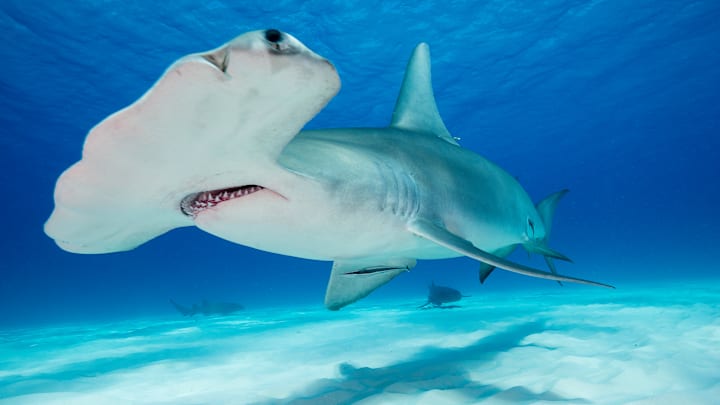The hammerhead shark doesn’t always get the respect it deserves. Thanks to their cartoonishly distanced eyes, they typically have a blind spot in front of their snout where schools of fish can safely congregate. Fin placement often leads to a peculiar tilt to their bodies while swimming. They are, in short, nature’s goofballs.
While they may be funny-looking, hammerheads practice a high-stakes game of hunting other shark species—an urge that hasn’t been well understood by science until now.
A Shark-Eat-Shark World
In a new study published in the journal Oecologia, scientists at Florida International University are disclosing new information about the dietary habits of hammerheads. While most shark species stick to a diet of relatively small and frequent portions, hammerheads tend to seek out large blacktip sharks, rays, and barracudas that require considerable energy to pursue and digest. (A hammerhead might weigh 250 pounds; a blacktip, 55 pounds.) Researchers wanted to know: Why go through all that extra trouble?
To get answers, nine hammerheads off the Gulf and Atlantic coasts in Florida were detained and equipped with biologging sensors that measure a shark’s swimming speed and location. Cameras were able capture video of their environment. They were then returned to the water, where researchers could monitor the hammerhead’s predatory activities and track their metabolic rate.
While hunting down blacktip sharks did demand a lot of energy, the pay-off was well worth it. Cornering a 55-pound blacktip, which amounts to roughly 20 to 25 percent of its own body weight, means that a hammerhead can meet its energy requirements for the next three weeks. That lump sum of metabolic effort is less than continuous energy spent chasing and eating much smaller reef prey on a near-daily or daily basis.
When food is especially scarce, it’s even possible that one blacktip binge meal could sustain a hammerhead for two months, providing it supplemented with daily feedings of tiny (0.5 pound) fish. Hammerheads also tend to forage in a timely manner, hunting blacktips in winter when the species is more abundant and thus easier to locate.
Why the Data Is Important
Great hammerhead sharks are classified as a critically endangered species, which makes understanding their survival needs vital to coming up with conservation strategies.
“In order to help protect critically endangered species like great hammerheads, we need to understand their underlying biology and how they interact with their environment,” marine ecologist and study co-author, Erin Spencer, PhD, said in a statement. “It's important that we continue to study these big questions, especially in the face of a changing ocean.”

The research was also successful in measuring traditionally difficult marine species. Unlike land animals, observing aquatic wildlife can be a logistical nightmare. Biologging—in this case, with sensors attached to the shark’s dorsal fin—can provide quality data on metabolic needs. It’s evidence that hammerheads use energy wisely in consuming 25 percent of their own mass at once, as compared to shark species that might consume 5 percent or less.
This isn’t FIU’s first exploration of hammerheads. In 2024, researchers found that a species of hammerhead, the scalloped bonnethead, stuck to certain areas off the Colombian coastline. By isolating their geographical preferences, it’s possible for conservationists to propose protected areas dubbed “no-take zones” where the species cannot be captured or removed.
Hammerheads can still show up in unexpected places. In June, one bonnethead dropped from the sky onto a disc golf course in Myrtle Beach, South Carolina. An osprey had dropped it after being attacked by two crows.
Bite Into More Shark Stories:
